Career Fire Fighter Dies from Fall off Fire Escape Ladder - Illinois
 Death in the Line of Duty…A summary of a NIOSH fire fighter fatality investigation
Death in the Line of Duty…A summary of a NIOSH fire fighter fatality investigation
F2010-25 Date Released: June 2, 2011
Executive Summary
On August 09, 2010, a 31 year-old male career fire fighter (the victim) died from a fall while climbing a fire escape ladder. Crews were responding to an alarm at a 4 story mixed occupancy structure. When crews arrived at 0031 hours, they noticed sparks emitting from the top of the roof near an external exhaust duct that originated in a street level restaurant. The victim and three other fire fighters were using an exterior fire escape to access the roof. At the fourth floor landing the victim started to ascend the vertical ladder to the roof carrying a 63 pound hand pump in his right hand while being supported by a fire fighter on the landing. When out of reach of the supporting fire fighter, the victim lost his grip on the ladder falling 53 feet to the pavement. The victim was transported to the local medical center where he was pronounced dead.
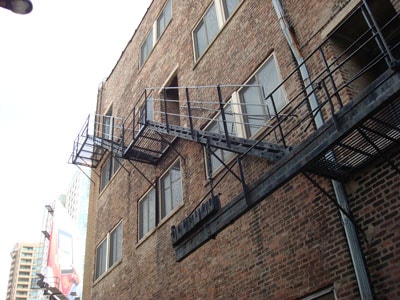
|
|
Fire Escape – Post Incident |
Contributing Factors
- Using a fire escape to access the roof rather than a safer means such as an aerial ladder or interior stairway
- Victim unable to maintain contact with the vertical portion of fire escape due to carrying the hand pump.
Key Recommendations
- Ensure that standard operating guidelines (SOGs)on the use of fire escapes are developed, implemented, and enforced
- Ensure that tactical level accountability is implemented and enforced
- Ensure that companies are rigorously trained in safe procedures for roof operations and climbing ladders of any type
- Ensure that fire fighters are rigorously trained in safe procedures for carrying and/or hoisting equipment when ascending or descending elevations
- Evaluate the fire prevention inspection guidelines and process to ensure that they address high hazard occupancies, such as restaurant, and incorporate operational crew participation.
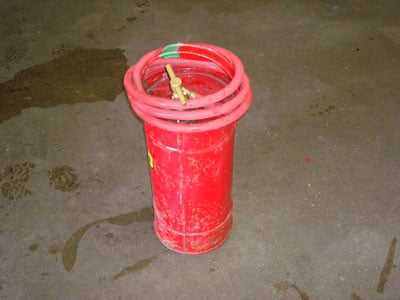
|
|
An example of a hand pump carried by the victim. The hand pump is a manually pressurized fire extinguisher. |
Introduction
On August 09, 2010, a 31 year-old male career fire fighter (the victim) died from a fall while climbing a fire escape ladder. On August 09, 2010, the U.S. Fire Administration notified the National Institute for Occupational Safety and Health (NIOSH) of this incident. On August 16-20, 2010, a general engineer and a safety and occupational health specialist from the NIOSH Fire Fighter Fatality Investigation and Prevention Program traveled to Illinois to investigate this incident. On August 26, 2010, the general engineer returned to complete interviews and collect additional records. The NIOSH investigators conducted an opening meeting with fire department officials. In a separate meeting NIOSH investigators met with the International Association of Fire Fighters Local Union President. The NIOSH investigators visited the incident scene and conducted interviews with officers and fire fighters who were at the incident. The NIOSH investigators reviewed the fire department’s standard operating guidelines, officers’ and fire fighters’ training records, dispatch audio tapes, and the county medical examiner’s autopsy report. In addition, NIOSH investigators reviewed the Fire Prevention Bureau’s Report of Inspection, dated June 23, 2010, and the Department of Buildings’ Emergency Order and Complaint Referral Form, dated August 9, 2010, requiring the repair of the grease chute.
Fire Department
This career fire department has 98 stations with 4,314 uniformed members which serve a population of approximately 2,851,000 within an area of about 228 square miles. Specialty units consist of swift water, ice rescue, hazardous materials, and technical rescue teams. All department members work a 24-hour duty shift with 48 hours off, and department members may be assigned to a fire apparatus for the entire 24-hour shift. The fire department operates 24 battalions in six divisions. The fire department currently has 96 engines, 61 aerial ladders, 4 squads (2 apparatus per squad consisting of a heavy rescue and a snorkel), 2 fire boats, and 2 helicopters. All fire department apparatus are maintained by the city’s fleet maintenance division with annual testing of fire apparatus and ambulances conducted by qualified vendors. All advanced life support ambulances are provided by the fire department.
The fire department has written policies and procedures, which are available to all department members within their stations. Policies and procedures on incident command structure, personnel accountability system, and truck operations were in place. The fire department has a training facility that is in operation 6 days a week from 0700 to 1700 hours. Note: At the time of this investigation, a written policy on fire escape use did not exist.
The Fire Prevention Bureau (FPB) is a critical component of the fire department’s effort to protect against the loss of life and property through enforcement of fire codes. The FPB has 4 area offices within the large metropolitan city in order to conduct general fire code inspections at businesses, schools, hotels, public places, and high-rise occupancies on an annual basis. Inspections focus on exit signs, fire alarm systems, sprinkler systems, standpipes, and fire pumps being within municipal code. In addition, the FPB looks at occupancy numbers, proper storage and handling of flammable products, fire safety procedures, and testing/licensing of fire prevention personnel and products.
Training and Experience
Table 1 lists the training and experience of the primary fire fighters involved in the incident.
Table 1. Training and Experience of Key Personnel
|
Fire Fighter
|
Training Courses | Years experience |
|---|---|---|
|
Victim |
Fire Fighter I and II, Introduction to Incident Command (ICS-100), Statewide Weapons of Mass Destruction (WMD) Response- Hazardous Material Operations, Hazardous Waste Operations and Emergency Response, Emergency Response to Terrorism Basic Concepts and various administrative and technical courses. |
10 |
|
Lieutenant #1 |
Fire Fighter I, Fire Fighter II, and Fire Fighter III; Hazardous Materials First Responder-Operations Hazardous Materials Technician A; Emergency Response to Terrorism Basic Concepts; OSHA Hazardous Waste Operations; Technical Rescue Awareness; Structural Collapse Operations, Rescue Specialist-Confined Space; Trench Operations; and various other administrative and technical courses. |
22 |
|
Lieutenant #2 (Covering a shift at an unfamiliar station) |
Fire Fighter I, Fire Fighter II, Fire Instructor I, Hazardous Materials First Responder-Operations Hazardous Materials Technician A, Emergency Response to Terrorism Basic Concepts, and various other administrative and technical courses. |
23 |
|
Battalion Chief (Incident Commander (IC)) |
Fire Fighter I, Fire Fighter II, and Fire Fighter III; IS 100, 200, 700 and 800; Bachelor of Science – Fire Science Management; Numerous Hazard Materials and Fireground Tactics courses; and various other administrative and technical courses. |
31 |
Note: Fire Fighter 1 and 2 qualification met the criteria for National Fire Protection Association (NFPA) 1001, Standard for Fire Fighter Professional Qualifications, Fire Fighter I and Fire Fighter II.
Structure
The incident involved an 8,500 square foot four-story mixed-occupancy structure that was built in 1882 (see Photo 1). The ground level contained a restaurant with the kitchen in the rear. The remaining three floors contained numerous small business office spaces and apartments. The structure had a large cargo elevator to the fourth floor and a stairwell from the ground floor to a bulkhead door to the roof. The exterior was brick with windows and doors on each floor providing access to an iron fire escape on the D-side of the structure. The fire escape had a vertical goose neck ladder from the fourth floor to the roof. The rungs on this vertical goose neck ladder were approximately 4 inches from the vertical wall, but in several locations the fire escape rungs were approximately 2 to 3 inches from the exterior brick wall trim. The membrane flat roof housed the elevator motor and electrical panel, provided access to the restaurant grease chute cleanout and was accessible through a bulkhead door from the stairwell.
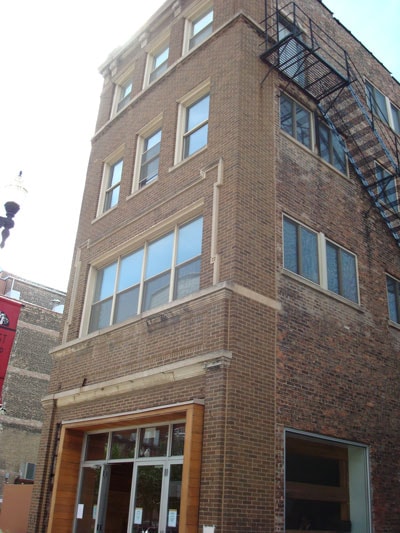
|
|
Photo 1: Four-story Incident Structure NIOSH Photo |
Equipment and Personnel
The fire department dispatched on first alarm a battalion chief, two engines, two trucks, and a squad consisting of two apparatus. Table 2 identifies the apparatus and staff dispatched on the first alarm, along with their approximate dispatch and arrival times on-scene (rounded to the nearest minute).
Table 2. First Alarm Equipment and Personnel Dispatched
|
Resource
Designation |
Staffing | Dispatched (rounded to minute) |
On-Scene (rounded to minute) |
|---|---|---|---|
|
Engine 5 (E5) |
Lieutenant |
0028 hrs |
0031 hrs |
|
Truck 2 (TR2) |
Lieutenant |
0028 hrs |
0032 hrs |
|
Truck 3 (TR3) |
Lieutenant |
0028 hrs |
0034 hrs |
|
Battalion Chief 3 (IC) |
Battalion Chief |
0028 hrs |
0039 hrs |
|
Ambulance 28 (A28) |
2 Paramedics |
0037 hrs |
0040 hrs |
|
Engine 42 (E42) |
Lieutenant |
0028 hrs |
0042 hrs |
|
Squad 1 (SQ1) |
Lieutenant |
0028 hrs |
0042 hrs |
Personal Protective Equipment
The victim was wearing his bunker coat and pants, gloves, hood, boots, helmet, self-contained breathing apparatus (SCBA) with an integrated personal alert safety system (PASS), and a radio.
Weather
The weather was cloudy with an approximate temperature of 81°F. The relative humidity was 62% and the wind was from the south-southwest at 10.4 miles per hour. 1 The weather did not play a role in the incident.
Investigation
On August 09, 2010, a 31 year-old male career fire fighter (the victim) died from a fall while climbing a fire escape ladder. At 0028 hours, crews were dispatched to a confined chimney or grease chute fire. At 0031 hours, E5 arrived and a minute later T2 arrived at the 4-story mixed occupancy structure. The crews noticed sparks emitting from the top of the roof near an external grease chute that belonged to the street level restaurant. The E5 Lieutenant (Lt #1) met with the building owner and walked down the D-side alley.
At 0034 hours, T3 arrived on scene and staged in a parking lot across the street on the A-side of the structure. Lt #1 entered a D-side alley door to the kitchen area of the restaurant with the building owner. The T2 lieutenant (Lt #2) followed. After assessing the interior conditions and ordering the restaurant patrons to evacuate the building, the lieutenants re-entered the alley. Lt #1 instructed Lt #2 to put T2’s aerial ladder to the roof. The T2 driver began setting the aerial to the roof.
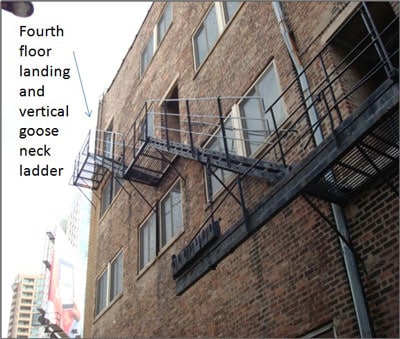
|
|
Photo 2: The Exterior Fire Escape
(NIOSH Photo) |
At 0039 hours, Battalion Chief 3 arrived on scene and assumed command. The IC met with the building owner and entered the D-side alley door. The victim, a fire fighter, and a candidate fire fighter were in the alley with tools and a hand pump. One of the fire fighters utilized a 6′ pike pole to pull down the fire escape stairs. Lt #2 assisted in holding down the fire escape stairs as the victim, the fire fighter, and the candidate fire fighter accessed the fire escape.
At 0042 hours, SQ1 and E42 arrived on scene (Diagram 1). SQ1 was assigned primary search and entered the kitchen area of the structure. The E42 crew assisted the E5 crew in connecting to the hydrant and stretching a 1 ¾” hoseline into the alley. The T2 driver set the aerial ladder to the roof and started to ascend the aerial with another fire fighter on the A-side of the structure.
At approximately 0045 hours, the victim, on the fourth floor landing, started to ascend the vertical ladder portion of the fire escape to the roof carrying a 63 pound hand pump in his right hand while being supported by the candidate fire fighter on the landing (see Photo 2). The victim continued up the ladder out of reach of the supporting candidate fire fighter. The victim’s foot knocked the candidate fire fighter’s helmet off as he tried to make another rung and was unable to maintain his grip on the ladder. The victim released his grip on the hand pump, which hit the candidate fire fighter on the landing, with no reported injury, and the victim fell 53 feet to the pavement. The victim landed on his right side and was immediately attended to by fire fighters and emergency medical technicians. The victim was transported to the local medical center where he was pronounced dead.
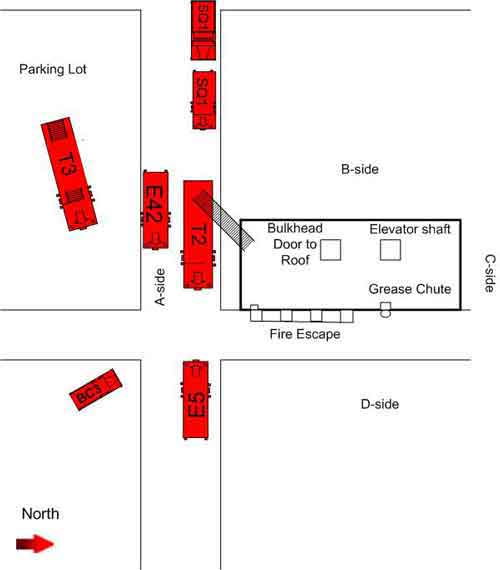
|
|
Diagram 1: Apparatus Placement |
Cause and Origin
Per the Department of Buildings Report, the restaurant’s cooking exhaust and ductwork system contained an excessive amount of creosote and other flammable resin from the cooking process. The wood-burning oven’s ventilation duct was tied into the grease chute providing an ignition source for the creosote and flammable resin. According to local building codes and the approved building plan, an independent exhaust ventilation system is required for the wood-burning oven.2
Contributing Factors
Occupational injuries and fatalities are often the result of one or more contributing factors or key events in a larger sequence of events that ultimately result in the injury or fatality. NIOSH investigators identified the following items as key contributing factors in this incident that ultimately led to the fatality:
- Using a fire escape to access the roof rather than a safer means such as an aerial ladder or interior stairway
- Victim unable to maintain contact with the vertical portion of fire escape due to carrying the hand pump.
Cause of Death
According to the death certificate, the medical examiner listed the victim’s cause of death as blunt force trauma as a result of the fall.

|
|
Photo 3: It is estimated that the victim’s footing made the seventh rung near the decorative trim piece where there was a minimal 2” to 3” boot clearance from the wall and ladder rung. |
Recommendations
Recommendation #1: Fire departments should ensure that standard operating guidelines (SOGs) on the use of fire escapes are developed, implemented, and enforced.
Discussion: External fire escapes are open metal stairways and ladders attached to the side of a building and were once a very important aspect of fire safety in urban areas. However, they have fallen out of common use by current building codes. Most modern building and fire codes require interior stairways with fire-rated enclosures as a means of emergency egress.
However, many cities have existing older structures that still have these external metal fire escapes. Often these fire escapes are not maintained or inspected to keep them in a safe condition to utilize. Since they are exposed to the weather at all times and may be decades old, the metal is often rusted and in need of repair. In addition, they are fastened or bolted to masonry construction on the exterior of the structure which degrades over the years. Fire fighters should assume that fire escapes are unsafe for use if they are rusty, have little or no paint, and/or if the masonry wall has missing mortar joints or cracked brick at the fire escape connection points. 3 Thus, aerial ladders, ground ladders and/or interior staircases with bulk head doors should be utilized as the primary means of ingress and egress to roofs.
Written SOGs enable individual fire department members an opportunity to read and maintain a level of assumed understanding of operational procedures. Conversely, fire departments can suffer when there is an absence of well developed SOGs. The NIOSH Alert: “Preventing Injuries and Deaths of Fire Fighters” identifies the need to establish and follow fire fighting policies and procedures.4 Guidelines and procedures should be developed, fully implemented and enforced to be effective. Periodic refresher training should also be provided to ensure fire fighters know and understand departmental guidelines and procedures.
During this incident, the victim, the candidate fire fighter and a fire fighter attempted to access the roof using the fire escape. T2’s roof crew was ascending the aerial ladder to the roof when the victim fell. The fire department had an unwritten policy that fire escapes were to only be used as a last resort.
Recommendation #2: Fire departments should ensure that tactical level accountability is implemented and enforced.
Discussion: Accountability includes more than a hardware tracking system and must be addressed at all levels on the fireground. The incident commander addresses the strategic level of accountability by knowing the location and function of sector crews on a tactical worksheet. Company officers must know the location and function of the assigned crews, and be in close proximity of their assigned area to maintain supervision of their crew. Company officers must constantly evaluate their crew member’s actions and be prepared to intervene against unsafe actions. An experienced and well trained company officer will communicate with his members or be familiar enough with them to know what tasks they are performing. Company officers must constantly evaluate their crew member’s actions and safety. Supervisory skills are a key component to keeping fire fighters safe, especially when the given order is not looked at favorably with the crew. Accountability is each fire fighter’s responsibility on the fireground and is a key component to keeping fire fighters safe while operating on the emergency scene. 5
In this incident, the victim made the decision to utilize the fire escape. Noticing that the victim was heading up the fire escape alone, a candidate fire fighter followed behind. The truck company officer had recently been promoted, was covering the shift at a station he normally did not work, and was unfamiliar with his crew. The truck company officer had been directed by the engine company officer to put the main aerial to the roof. The truck company officer directed his roof crew to utilize the aerial ladder as the victim, candidate fire fighter, and another fire fighter utilized the fire escape.
Recommendation #3: Fire departments should ensure that companies are rigorously trained in safe procedures for roof operations and climbing ladders of any type.
Discussion: Roof operations are among the most important and dangerous tactics on the fireground. For roof access, many fire departments primarily use the aerial ladder and proper aerial ladder placement is essential for safe roof access. Depending on the structure type and location, other roof access methods may be available such as interior stairways that lead to a bulkhead door to the roof. Fire escapes are not usually a viable option because their structural condition can’t be verified at the time of the incident. Once the roof is accessed, fire fighters must conduct a quick roof size-up before stepping off a ladder or walking through a bulk head door. Fire fighters should note the location of any hazards such as trip hazards, openings, elevation changes, wires, etc, and always sound the roof deck for sturdiness. 6
The use of ladders in the fire service is well established. All the various types of fire service ladders have names and often these names will describe their intended use. In order to maintain the safe and efficient use of these ladders, fire fighters must be rigorously trained to know the characteristics and proper uses of these various types of ladders.7 Fire fighters are expected to be in full PPE and carry/hoist needed equipment and/or tools while climbing. This causes a safety concern when trying to maintain a three point contact while climbing ladders. Three point contact means 2 hands and one foot or both feet and one hand are in contact with the ladder at all times which is a recommended safety practice. 8 Although the vertical ladder portion of the fire escape is not a fire department ground ladder, it is a good safety practice per NFPA 1932, Section 5.1.9, that a Class I harness or ladder belt be worn when a ladder with a vertical angle less than 70 degrees is utilized. 9
During this incident, the victim accessed the fire escape while the roof crew had set the aerial to make access. Although the fire escape was structurally sound, the primary access method to the roof was the aerial ladder by unwritten fire department procedures. The victim was wearing rubber fire fighter boots, and in conjunction with the small wall clearance, there would have been minimal footing on the ladder rungs. In several locations the fire escape rungs were approximately 2 to 3 inches from the exterior wall due to the decorative concrete trim (see Photo 3). Note: Per the Occupational Safety and Health Administration (OSHA) 3124-12R 2003, the minimum perpendicular clearance between fixed ladder rungs, cleats, and steps and any obstruction behind the ladder must be 7 inches (18 cm), except that the clearance for an elevator pit ladder must be 4.5 inches (11 cm). 10 Although fire escapes are not specially mentioned in the referenced OSHA publication, ensuring sufficient clearances between the fixed ladder portion of fire escapes and buildings would be a good safety practice for fire departments in the event that fire escapes have to be used.
Recommendation #4: Fire departments should ensure that fire fighters are rigorously trained in safe procedures for carrying and/or hoisting equipment when ascending or descending elevations.
Discussion: Firefighting is very physically demanding. Fire fighters carry 80 – 100 lbs. of equipment such as hoses, axes, ladders, chain saws and extinguishers into and around the fire scene to rescue victims and extinguish the fire. This may include climbing many flights of stairs or ladders. One of the most common tools in the fire service for carrying, raising, or lowering various tools and equipment from one elevation to another is rope and webbing. The International Fire Service Training Association’s Essentials of Fire Fighting and Fire Department Operations states: “To use rope safely and effectively during fires and rescue operations, fire fighters must know the various types of rope and their applications. Fire fighters must be capable of tying a variety of knots and hitches quickly and correctly.” 7 Webbing generally is used as a sling to carry various types of equipment. The use of webbing, rope and knots is an essential part of Fire Fighter I training and fire departments should conduct annual refresher training on these skills.
The fire department trains using the above mentioned reference but a specific fire department standard operating guideline (SOG) should be generated. Another source for training and proficiency guidelines is NFPA 1410, Section 9.3.1, which details a recommended performance criteria for truck company personnel and the use of ropes, knots, and hitches for the hoisting of tools and appliances.11
In this incident, the victim opted to ascend the gooseneck ladder portion of the fire escape while carrying the hand pump instead of hoisting it from the landing to the roof with a rope or webbing. This resulted in the inability to maintain 3-point contact with the ladder.
Recommendation #5: Fire departments should evaluate the fire prevention inspection guidelines and process to ensure that they address high hazard occupancies, such as restaurant, and incorporate operational crew participation.
Discussion: The fire department’s Fire Prevention Bureau conducts annual inspections of the restaurants in the area. The last inspection was conducted at the mixed occupancy structure in June 2010, approximately 7 weeks prior to the incident. Several violations were noted dealing with egress, such as, repair of panic hardware and illuminated signs. In addition, wood and debris needed to be removed from the rooftop. The June 2010 inspection report did not indicate if the grease duct was inspected, which was the cause and origin of the fire. According to the city’s Department of Buildings’ (who enforce the building codes) post inspection report (August 2010), the grease duct and ventilation system were not within code. 2
The Department of Buildings and the Department of Public Health routinely conduct inspections of restaurants to enforce municipal building and health codes. Perhaps communication between these departments and the fire department could be improved to coordinate inspections or be cross-trained on municipality and fire safety codes. A best practice of occupancy specific inspection forms/checklists should be developed and utilized by the Fire Prevention Bureau. These inspection forms/checklists could be provided to the fire department’s operational units within that occupancy’s area to participate in the fire prevention inspection. Operational units could be required to participate in a set number of inspections per week. The unit commanders (Captains) could be granted the flexibility to determine the frequency of the inspection for each commercial building in their district. All commercial buildings should be inspected at least once every five years and more often for higher risk structures. Occupancies that are retail food establishments would be required to have annual inspections of their kitchen range hoods, grease chutes, and ventilation systems to ensure no changes to the equipment or fire suppression system have occurred. This process enables the operational units to become familiar with the occupancies and specific life hazards that may be present in their district.
The primary goal of a progressive fire department is to prevent fires from occurring. In order to achieve this, an aggressive well trained force capable of recognizing, citing, and eliminating potential hazards can result in preventing fires. Ultimately, fire prevention enhances fire fighter safety.
References
- Weather Historyexternal icon http://www.wunderground.com/history/airport/KMDW/2010/8/9/DailyHistory.html?req_city=Chicago&req_state=IL&req_statename=Illinois
- Department of Buildings. Emergency Police Powers Order. August 9, 2010.
- Flynn, J [2009]. Operating Safely on Fire Escapes. http://www.fireengineering.com/index/articles/display/355900/articles/fire-engineering/volume-162/issue-3/features/operating-safely-on-fire-escapes.html. Date accessed: May 23, 2011.
- NIOSH [1994]. NIOSH Alert: Preventing Injuries and Deaths of Fire Fighters. Cincinnati, OH: U.S. Department of Health and Human Services, Public Health Service, Centers for Disease Control and Prevention, National Institute for Occupational Safety and Health, DHHS (NIOSH) Publication No.# 94-125.
- Parks, B [2008]. Fireground Accountability – A ‘System’ to Keep Firefighters Safe.external icon http://www.firerescue1.com/print.asp?act=print&vid=403750. Date accessed: May 24, 2011.
- Troxell, DM [2010]. Primary Roof Ventilation Operations for Flat-Roof Structures.external icon http://www.fireengineering.com/articles/2010/08/primary-roof-ventilation-operations-for-flat-roof-structures.html. Date accessed: May 24, 2011. (Link Updated 1/28/2013)
- International Fire Service Training Association [2008]. Essentials of Fire Fighting and Fire Department Operations, 5th ed. Stillwater, OK: Fire Protection Publications, Oklahoma State University.
- OSHA [2005]. Portable Ladder Safety Tips.external icon Washington D.C., U.S. Department of Labor, Occupational Safety and Health Administration, (OSHA) Publication 3267-09N-05. https://www.osha.gov/Publications/portable_ladder_qc.html. Date accessed: May 23, 2011.
- NFPA [2010]. NFPA 1932: Standard on Use, Maintenance, and Service Testing of In-Service Fire Department Ground Ladders. 2010 ed. Quincy, MA: National Fire Protection Association.
- OSHA [2003]. Stairways and Ladders – A Guide to OSHA Rules.external icon Washington D.C., U.S. Department of Labor, Occupational Safety and Health Administration, (OSHA) Publication 3124-12R 2003. https://www.osha.gov/Publications/ladders/osha3124.html. Date accessed: May 24, 2011.
- NFPA [2010]. NFPA 1410: Standard on Training for Initial Emergency Scene Operations. 2010 ed. Quincy, MA: National Fire Protection Association.
Investigator Information
This incident was investigated by Matt E. Bowyer, General Engineer and Stephen Miles, Safety and Occupational Health Specialist, with the Fire Fighter Fatality Investigation and Prevention Program, Surveillance and Field Investigations Branch, Division of Safety Research, NIOSH located in Morgantown, WV. An expert technical review was provided by Richard S. Tobin, Assistant Chief, New York City Fire Department. A technical review was also provided by the National Fire Protection Association, Public Fire Protection Division.
Disclaimer
Mention of any company or product does not constitute endorsement by the National Institute for Occupational Safety and Health (NIOSH). In addition, citations to Web sites external to NIOSH do not constitute NIOSH endorsement of the sponsoring organizations or their programs or products. Furthermore, NIOSH is not responsible for the content of these Web sites.
|
The National Institute for Occupational Safety and Health (NIOSH), an institute within the Centers for Disease Control and Prevention (CDC), is the federal agency responsible for conducting research and making recommendations for the prevention of work-related injury and illness. In 1998, Congress appropriated funds to NIOSH to conduct a fire fighter initiative that resulted in the NIOSH “Fire Fighter Fatality Investigation and Prevention Program” which examines line-of-duty-deaths or on duty deaths of fire fighters to assist fire departments, fire fighters, the fire service and others to prevent similar fire fighter deaths in the future. The agency does not enforce compliance with State or Federal occupational safety and health standards and does not determine fault or assign blame. Participation of fire departments and individuals in NIOSH investigations is voluntary. Under its program, NIOSH investigators interview persons with knowledge of the incident who agree to be interviewed and review available records to develop a description of the conditions and circumstances leading to the death(s). Interviewees are not asked to sign sworn statements and interviews are not recorded. The agency’s reports do not name the victim, the fire department or those interviewed. The NIOSH report’s summary of the conditions and circumstances surrounding the fatality is intended to provide context to the agency’s recommendations and is not intended to be definitive for purposes of determining any claim or benefit.
|
For further information, visit the program Web site at www.cdc.gov/niosh/fire or call toll free 1-800-CDC-INFO (1-800-232-4636).
This page was last updated on 05/25/2011.
